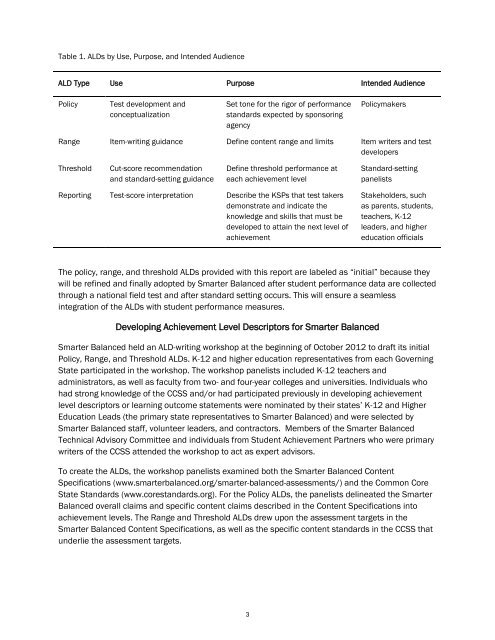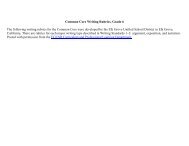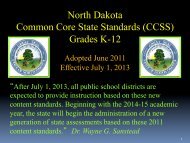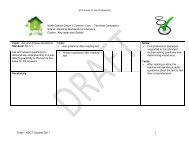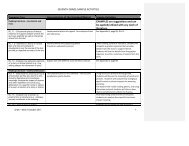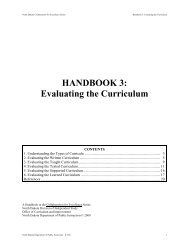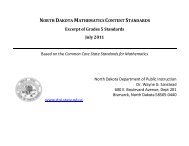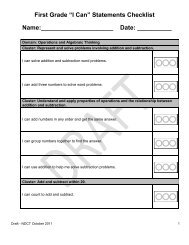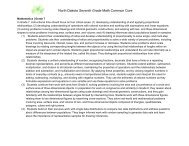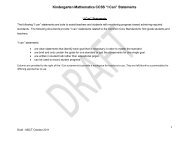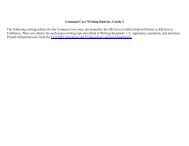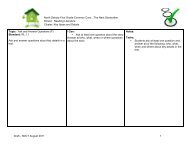SBAC Achievement Level Descriptors, Grade 4 - ND Curriculum ...
SBAC Achievement Level Descriptors, Grade 4 - ND Curriculum ...
SBAC Achievement Level Descriptors, Grade 4 - ND Curriculum ...
You also want an ePaper? Increase the reach of your titles
YUMPU automatically turns print PDFs into web optimized ePapers that Google loves.
Table 1. ALDs by Use, Purpose, and Intended AudienceALD Type Use Purpose Intended AudiencePolicyTest development andconceptualizationSet tone for the rigor of performancestandards expected by sponsoringagencyPolicymakersRange Item-writing guidance Define content range and limits Item writers and testdevelopersThresholdCut-score recommendationand standard-setting guidanceDefine threshold performance ateach achievement levelStandard-settingpanelistsReporting Test-score interpretation Describe the KSPs that test takersdemonstrate and indicate theknowledge and skills that must bedeveloped to attain the next level ofachievementStakeholders, suchas parents, students,teachers, K-12leaders, and highereducation officialsThe policy, range, and threshold ALDs provided with this report are labeled as “initial” because theywill be refined and finally adopted by Smarter Balanced after student performance data are collectedthrough a national field test and after standard setting occurs. This will ensure a seamlessintegration of the ALDs with student performance measures.Developing <strong>Achievement</strong> <strong>Level</strong> <strong>Descriptors</strong> for Smarter BalancedSmarter Balanced held an ALD-writing workshop at the beginning of October 2012 to draft its initialPolicy, Range, and Threshold ALDs. K-12 and higher education representatives from each GoverningState participated in the workshop. The workshop panelists included K-12 teachers andadministrators, as well as faculty from two- and four-year colleges and universities. Individuals whohad strong knowledge of the CCSS and/or had participated previously in developing achievementlevel descriptors or learning outcome statements were nominated by their states’ K-12 and HigherEducation Leads (the primary state representatives to Smarter Balanced) and were selected bySmarter Balanced staff, volunteer leaders, and contractors. Members of the Smarter BalancedTechnical Advisory Committee and individuals from Student <strong>Achievement</strong> Partners who were primarywriters of the CCSS attended the workshop to act as expert advisors.To create the ALDs, the workshop panelists examined both the Smarter Balanced ContentSpecifications (www.smarterbalanced.org/smarter-balanced-assessments/) and the Common CoreState Standards (www.corestandards.org). For the Policy ALDs, the panelists delineated the SmarterBalanced overall claims and specific content claims described in the Content Specifications intoachievement levels. The Range and Threshold ALDs drew upon the assessment targets in theSmarter Balanced Content Specifications, as well as the specific content standards in the CCSS thatunderlie the assessment targets.3


